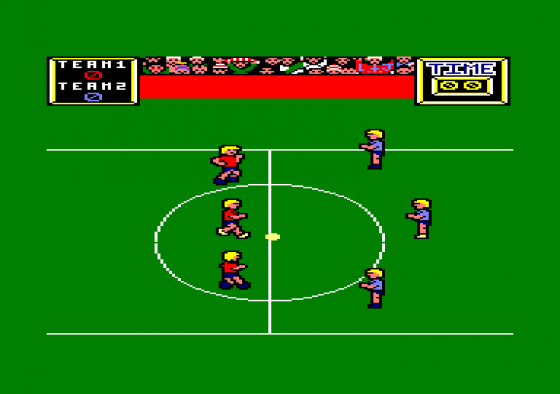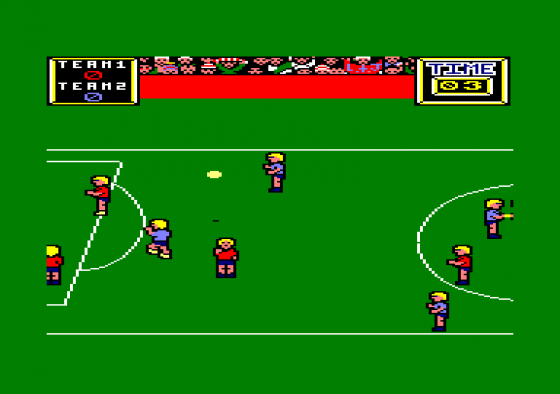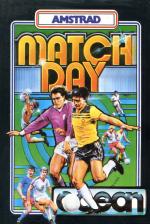
Amstrad Action
 1st November 1985
1st November 1985
Categories: Review: Software
Publisher: Ocean
Machine: Amstrad CPC464
Published in Amstrad Action #2
Match Day
The first football simulation on the Amstrad was World Cup from Artic and initially this doesn't look that different. However, once you realise the depth of extra features and gameplay it really stands out as a terrific program.
The action takes place on a 3D scrolling pitch with a goal at either end. The display is similar to World Cup and Slapshot with pitch markings and a crowd at the top of the screen. The teams are made up of seven players and a goalkeeper, with three in defence, one in midfield and three in attack. These allocations are not rigid, though, and players can dribble the ball anywhere on the field.
The matches can take two general formats, either a one-off game or an eight team knockout competition. Games can be played over a duration of 10, 30 or 90 minutes and are split into two halves. They can also be played against the computer or an opponent with the computer having three levels of skill.

The cup competition can have up to eight players taking part in the tournament but a single player can battle it out with the eight computer teams if he wants to. All of these options as well as strip colours, team names and controls are selected before the game begins.
The players emerge to the Match Of The Day theme music (old version) and line up on the pitch with you having a view of the centre circle. Then comes the kick-off and it's all action from there on. The aim, Brian, is obviously to put the ball in the back of the net. There are many features that may help you do this.
A player in possession of the ball can dribble it along, but if he encounters an opponent, he may be blocked or have the ball stolen off him. You always control the player on your side with possession. If the other team have the ball then you control the player who is nearest the ball or towards whom the ball is heading. This is indicated by the player's boots turning brown instead of the usual black.

The ball can be kicked around either in the air or on the ground but either way you can gin control of it by running into it when it is on the ground or after chesting it down. The ball and other players can't pass through you so obstruction tactics and deflecting the ball can be quite handy.
Scoring is simply a matter of hitting the ball in the air or on the ground towards the goal, or even just running it on the end of your boot. You can control your goalkeeper when the opposition are close to your goal to block shots. This is best done when it's in the air (the timing is still difficult) but if they shoot along the ground or run the ball in you're very much dependent on interposing a defender to save the day.
Players not under your control will tend to take up their normal positions but provide general support and move into positions where they can be passed to.

The graphics and animation are good, providing a more playable game than World Cup with many more features. The music at the beginning and end of each match is good and the multi-player option can provide some exciting and enjoyable competitions. The computer's pretty good too.
Second Opinion
This is probably the only chance you'll get this year to hear the Match Of The Day theme tune, so make the most of it. The graphics are very pretty, even if it looks like Wolves v. Man. Utd. each time, and the movement is smooth enough for you to display your silky skills. If you've got any. This is a game that should go straight to the top of the table.
Good News
P. Good graphics and animations.
P. Lots of good footballing elements in the gameplay.
P. Fine start and finish music.
P. Two types of competition.
P. Exciting two player action.
P. Many features allowing you to mould the game to your taste.
Bad News
N. Computer opponent may not be tough enough.
N. Not always clear which player you will be controlling when not in possession.
Not Just Kick And Run
There are several features of the game that make it more than just a kick and run simulation - it takes skill as well.
HEADING: You can bounce a ball in the air off your head and even keep it up there for a while, although guiding it is difficult.
THROW-INS: The computer recognises who last touched the ball before it went out of play and awards throw-ins accordingly. You can aim the ball in several directions as it is raised above the player's head and then throw it. N.B. you can't score direct from a throw-in.
GOAL KICKS. Occur when the ball goes over the end line but not in the goal. They are taken from the correct side of the six yard box.
KICK OFFS: From the centre circle.
OWN GOALS: If you're careless enough or unlucky you can put the ball in your own net - it's all the same to the scoreboard.
POSTS: You can actually bounce the ball off the posts or the crossbar, but you may be able to follow it up.
CORNERS: Taken from the opposition's corner flag so that you can knock it into their area for incoming attackers.
TRAPPING THE BALL: skilled players can intercept a bouncing ball just as it hits the turf and trap it, enabling them to then dribble it.



